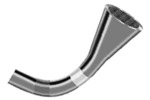Features
For instruments: Comstock Mini-TOF, Amersham Eltan
- "Plug-in" Compatible
- High Sensitivity
- Low Noise
- High Gain
- Long Life
- Stable in air
ETP Active Film Multipliers™ are the latest development in electron multiplier technology. They incorporate a discrete dynode structure and are designed specifically for use where high sensitivity, low noise and longer operation life is demanded.
Description
For instruments: Comstock Mini-TOF, Amersham Eltan
TOF Detectors (Flat/orthogonal ion impact surfaces, narrow pulse width, large dynamic range). Bakeable to 350 °C. Maximum sustained output current limit for linear operation of 5 micro amps. Available with the high current option by adding the suffix “H” to the part number. This increases the sustained output current limit for linear operation to 30 micro amps and decreases the internal resistance to 10% of the standard value.
Specs
| Description | TOF detector for Comstock MiniTOF / Amersham Eltan |
|---|---|
| Sensitive Area (mm) | 8 x 10 side entry |
| Mechanical Envelope Dimensions | 110 x 21 x 25 |
| Pulse width single ion event/multiple ion event (ns, fwhm) | 4.5/6 |
| Recovery time after large pulse (500mv into 50ohms) | <30ns |
| Maximum pulse amplitude for linear operation | 500mv into 50ohms |
| Max sustained output current for linear operation | 5 µA |
| Max Dark Noise @ 1e7 gain | 3ct./min |
| Internal resistance (MΩ) | 34 |
| Number of Dynodes | 20 |
| Gain Curve (see chart) | D |
Technical
Care and Handling
ETP Electron Multipliers are incorporated as original equipment in all areas of mass spectrometry and surface science, as well as a diverse range of analytical and general physics applications. They offer the performance required by modern instrumentation and have a proven reputation for reliability and ruggedness.
The original packing supplied by ETP is suitable for long term storage. The multiplier is enclosed in two sealed plastic bags. The outer bag contains a silica gel package to minimize adsorption of moisture, which could otherwise lead to excessive outgassing upon installation. Contained in its original packaging, the shelf-life of an ETP Electron Multiplier is guaranteed for up to two years from the date of shipment. If it is necessary to store the multiplier outside its original packaging, it should be kept in a clean, dust-free, low-humidity environment, such as a glass desiccator.
In order to minimize contamination, standard high-vacuum techniques are recommended when handling ETP Electron Multipliers. Clean, powder-free nitrile or latex gloves or finger cots should be worn to prevent the transfer of skin oils to critical or mounting surfaces of the multiplier. All tools, mountings, and equipment should be thoroughly cleaned (see instrument manual) prior to coming in contact with the multiplier.
(WARNING) Care should be taken to minimize exposure of the multiplier to dust or other airborne contamination. Dust particles within the detector may result in increased background noise during operation.
(WARNING) Exposure of the multiplier to high humidity should be avoided in order to minimize outgassing during initial operation. Excessive noise due to adsorbed moisture may be rectified by leaving the multiplier under high vacuum for 24 hours
Installation
Installing and Operating
ETP Electron Multipliers generally require no preconditioning if stored correctly. The multiplier should be installed according to the instrument manufacturer’s instructions. There should be no sharp objects in close proximity to the entrance aperture as this could result in noise during operation. Operating pressure should be as low as possible for best lifetime and minimum noise. To avoid risk of damage due to discharge or arcing, the multiplier should not be operated at a pressure in excess of 1 x 10-4 Torr.
(WARNING) Applying the maximum rated supply voltage to a new multiplier can cause damage and permanent loss of gain.
(WARNING) Do not increase the applied voltage to a multiplier to overcome background noise as this can cause permanent loss of gain.
Obtaining Optimum Lifetime from an ETP Electron Multiplier
Operational life varies depending on application and can be affected by the following factors:
- Operating Environment: Lower operating pressure and lower partial pressure of hydrocarbons in the vacuum chamber will result in increased operational life, all other conditions remaining the same.
- Operating Gain: Operation should always be at the lowest applied voltage consistent with good signal acquisition. In general, the lower the gain, the longer the life of the multiplier. The gain of a electron multiplier will fall gradually over time, requiring the applied voltage to be periodically increased. This is a normal part of the multiplier aging process.
- Output Current: Multiplier lifetime is inversely proportional to average output current. Excessive input signals should be avoided, especially when operating at high gain.
Rapid degradation of multiplier performance may result from failure of the vacuum pumping system. This may cause severe contamination of the detector or damage due to arcing caused by the sudden increase in chamber pressure. Degradation caused by vacuum failure may be permanent and irreversible, especially if the multiplier supply voltage was ON during the vacuum failure.
NOTE: Due to the wide variety of applications and environmental conditions within instruments, there is no warranty on the operational lifetime of any electron multiplier.
ETP does not recommend washing or cleaning of multipliers.
Warranty
Contact Us for extra ETP information.




